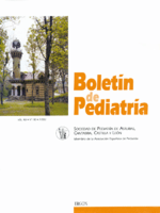Parálisis braquial obstétrica. Importancia de la utilización de un protocolo diagnóstico y terapéutico
M.J. Conde , C. Baza Vilariño , R. Arteaga Manjón-Cabeza , J.L. Herranz Hernández
Bol. Pediatr. 2002; 42 (180): 106 - 113
Objetivo: Proponer un protocolo para el diagnóstico y el tratamiento de los niños con parálisis braquial obstétrica (PBO). Desarrollo: La PBO es una entidad relativamente frecuente, puesto que afecta a 1-2,5 de cada 1.000 recién nacidos vivos. Tras revisar las historias clínicas de nuestro servicio en los últimos 8 años y los principales estudios publicados sobre la PBO, se propone una pauta diagnósticoterapéutica cuyo objetivo es minimizar en lo posible las secuelas y obtener la normalización clínica en todos los pacientes. Conclusiones: La sistematización en los controles de los niños con PBO es fundamental para evitar secuelas irreversibles. Por ser una patología neurológica, parece oportuno que sea el neuropedíatra el que coordine el seguimiento de estos pacientes. Abstract Objective: Propose a protocol for the diagnosis and treatment of children with obstetric brachial paralysis (OBP). Development: The OBP is a relatively frequent entity since it affects from 1-2.5 of every 1,000 live newborns. After reviewing the clinical histories of our service in the last 8 years and the principal studies published on the OBP, a diagnostic-therapeutic guideline whose objective is to minimize the sequels as much as possible and obtain clinical normalization in all the patients is proposed. Conclusions: Systematization in the controls of the patients with OBP is essential to prevent irreversible sequels. As this is a neurological disease, it seems to be appropriate for the neuropediatrician to coordinate the follow-up of these patients.
\N
\N
Artículo completo (PDF) (75 kb.)
- Neurología
